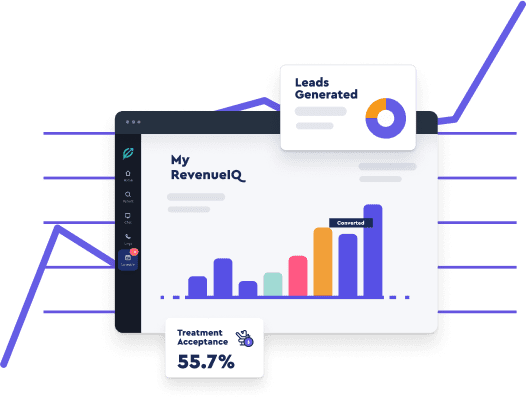Dental Practice Analytics: How to Turn Data into Strategy?

Imagine it’s Monday morning. You’re juggling no-shows, tracking production numbers, and wondering why hygiene revenue dipped last month. You don’t have time to dig through reports—or guess what went wrong. That’s where dental analytics for practice steps in.
You need precise, actionable data showing where patients are falling off, which seats are under booked, and how each marketing dollar performs. Not vague metrics—real, practice-specific insights that serve as your roadmap to help you take immediate action.
This blog is for dental leaders ready to stop reacting and start optimizing. We’ll show you how to turn raw numbers into strategies that reduce cancellations, improve case acceptance, and drive consistent revenue without adding to your workload. If you’re serious about scaling your practice without burning out, it starts with understanding your data.
Why Is Data Important in Dental Practices?
Data lies at the heart of every decision made within a dental practice. Think about all the moving parts in your dental practice—patient visits, treatment plans, no-shows, and production goals. Now, imagine being able to track all of that in real time. That’s the power of data.
It’s not just numbers on a dashboard; it’s the key to understanding what’s helping your practice grow and holding it back.
Want to know why patients aren’t coming back, or which clinician is most productive?
Data gives you those answers. It takes the guesswork out of decisions and helps you run your practice with more confidence, clarity, control, and understanding of key performance indicators.
What Are the Required Metrics and KPIs for Dental Practices?

You probably know your regular patients by name. But do you know their demographics? Tracking age, gender, location, insurance coverage, and dental history gives you the insights to personalize care, simplify scheduling, and communicate more effectively. These details help you anticipate needs—whether it’s age-specific oral health issues or location-based reminders—and build stronger, longer-term relationships with your patients.
2. Patient Conversion Rates
How many of your new patients return? If your answer is “I think most of them,” it’s time to dig deeper. Conversion rates track how many first-time visitors become loyal patients. You can monitor everything from appointment booking to treatment acceptance with the right tools. If there’s a drop-off, you’ll know where, why, and, more importantly, how to fix it.
3. Treatment and Procedures Analytics
Not all treatments are created equal—some take longer, some have higher acceptance, and others drain more resources. By tracking the treatment outcomes, what, how, and how often of every procedure, you can uncover gaps in efficiency, reduce patient wait time, and even discover new revenue opportunities. It’s like having a microscope on your treatment workflow.
4. Financial Metrics and Insurance Claims
Let’s talk numbers—real ones. Your practice’s health isn’t just about happy smiles; it’s also about cash flow. From monthly revenue trends to unpaid insurance claims, financial metrics help you understand where your money is coming from—and where it’s stuck. Clean, timely claims and steady collections mean fewer financial headaches and more room to grow.
5. Staff Performance and Operational Efficiency
Your team is the engine behind every smooth appointment and successful procedure. Dental analytics lets you track how each team member contributes—whether it’s front-desk scheduling, hygienist productivity, or follow-up coordination. When you have visibility into team performance, you’re not just managing people—you’re empowering them.
Why to Choose Dental Practice Analytics Software?
Dental analytics software streamlines data management enhances patient care, and boosts practice efficiency. Detailed insights and reporting features enable informed decision-making to improve overall performance. Thus, you must embrace technology for better outcomes in your dental practice. Here are all the reasons why choose dental analytics software.
1. Enhanced Treatment Plan Acceptance
When patients say, “I’ll think about it” after a treatment plan, chances are… they won’t. That’s where software steps in. With everything in one place—treatment history, insurance details, new patient paperwork, preferences—your team doesn’t need to scramble for answers. They can confidently present plans that make sense to the patient.
Visual tools make a big difference, too. Instead of explaining a root canal with words, you show patients what’s happening. Add automated reminders for unscheduled treatments, and you’ve created a seamless system that moves patients from “maybe later” to “let’s book it.”
2. Patient Loyalty and Retention
It’s easy to focus on new patients, but the real win? Keeping the ones you’ve already earned. Patient retention isn’t just about service—it’s about staying top of mind. And dental practice software makes it effortless.
From automated appointment reminders to thoughtful birthday messages and follow-ups, it helps your team stay connected without lifting a finger. Personalized recall scheduling based on treatment history? Even better. It shows patients they’re more than a name on a chart, which keeps them returning.
3. Optimizing Appointment Scheduling and Follow-ups at the Front Office
No one likes an overbooked morning or a slow afternoon. But let’s face it: manual scheduling doesn’t always get it right. That’s where software changes the game.
It factors in things like provider availability, patient preferences, and equipment needs—all in real-time. Need to avoid gaps in the schedule? Done. Want to reduce last-minute cancellations? Automated reminders take care of that, too. And when follow-ups don’t slip through the cracks, you’re staying organized and improving care.
4. Outcome-Focused Dentistry
It’s not just about fixing teeth anymore. Patients care about the big picture—comfort, aesthetics, and long-term function. Dental software helps you track those outcomes.
You can see how patients feel post-treatment, what’s working, and where adjustments are needed. It’s about turning feedback and data into better results—without the guesswork. And when your treatments lead to noticeable, lasting improvements, your patients don’t just leave with better smiles—they go with stronger trust in your care.
How to Overcome the Challenges of Data Analytics?
Data alone won’t transform your dental practice—it’s how you use it that counts. From underutilized reports to limited access and security risks, dental teams face real hurdles. But with the right tools and strategy, you can turn raw numbers into smarter decisions and better patient care. Here’s what need to be taken care of:
1. Not Making Use of the Data
Collecting data is easy—actually using it is where most practices fall short. You might be tracking no-shows, revenue, or treatment plans, but if no one’s reviewing that data or using it to improve operations, it’s just sitting there. Make it a habit to regularly check insights and tweak your workflow or marketing strategies accordingly.
2. Not All Dental Practice Management Software Offers Practice Analytics
A lot of dental software tools are great for scheduling or billing, but when it comes to analytics? Not so much. You need a platform that breaks down key metrics like production per provider, patient retention, and new patient growth. Without this, it’s hard to measure real performance or spot what needs fixing.
3. Data Must Be Kept Secure
When dealing with patient information, data security isn’t optional—it’s critical. Any software you use should meet HIPAA standards and offer strong encryption, secure logins, and access controls. It’s not just about compliance; it’s about earning and keeping your patients’ trust.
4. Limited Accessibility
If your data’s locked away on a single computer or tied to one login, it limits your flexibility. Especially in busy or multi-location practices, it’s important to have cloud-based tools that let you access analytics from anywhere, so you can stay informed and make decisions even when you’re off-site.
Turn Data Into Growth with Practice by Numbers’ Practice IQ
Tired of sifting through clunky spreadsheets or guessing why numbers don’t match up? Practice IQ by Practice by Numbers puts all your key dental metrics into one intuitive dashboard—real-time, filterable, and built specifically for practices like yours.
Whether you’re a solo practitioner or managing multiple locations, Practice IQ helps you go beyond surface-level reports. It’s not just about seeing your numbers—it’s about finally understanding them. To book a demo, call us at 866-216-8416 or book a demo online!
Conclusion: Turning Data into Strategic Insights
Dental data analytics is the secret sauce that helps you turn data into growth, driving smarter decisions that improve patient care and business outcomes. Analytics covers everything from understanding patient demographics to boosting treatment acceptance rates, optimizing schedules, and building lasting patient relationships.
With the right dental practice management software, you can access real-time data that empowers your team to act quickly, track performance, and stay ahead of any potential roadblocks. This isn’t just about numbers; it’s about creating a practice that runs efficiently and enhances patient satisfaction while remaining patient-focused.
The future of dentistry is about more than just treating teeth—it’s about creating seamless, personalized, and profitable patient experiences. And analytics? It’s the key to making that happen by identifying areas of opportunity. As we move forward, the role of data in driving dental practice success will only become more vital. Don’t let your practice fall behind.
Frequently Asked Questions
What is a good EBITDA for a dental practice?
EBITDA, or Earnings Before Interest, Taxes, Depreciation, and Amortization, measures a practice’s operating performance. A good EBITDA margin for a dental practice generally falls between 15% and 20%, but this range can vary depending on factors such as location and practice size.
What are common challenges in implementing dental analytics?
Common challenges in implementing dental analytics include data integration difficulties, a lack of technological competence, data privacy concerns, and staff resistance to change. A thoughtfully selected dental practice management software can significantly help overcome these hurdles.
How can dental analytics improve patient outcomes?
Dental analytics can enhance patient outcomes by providing practitioners with real-time insights about patient profiles and family members, thus enabling personalized treatment. Additionally, data from these analytics can reveal trends and patterns in patient responses to treatments, informing necessary adjustments to treatment plans.
What trends are emerging in the field of analytics for dental practice?
Emerging trends include predictive analytics, AI-powered tools for better data analysis, drill-down analytics for granular insights, focus on patient experience metrics, integration with digital marketing strategies, and adoption of cloud-based solutions for more accessible and efficient data management.





